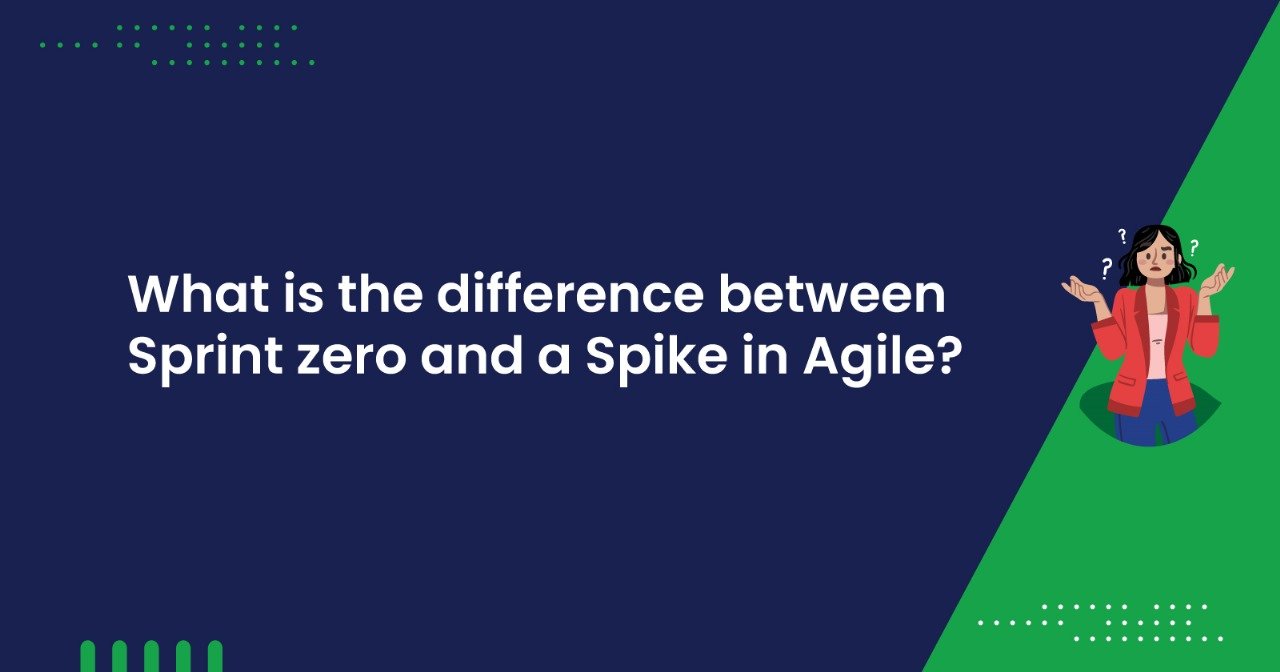Tech
What is the difference between Sprint zero and a spike in Agile?
Published
4 months agoon
By
IQnewswire
Introduction
Agile project management relies on spike and sprint zero to deliver high-quality outcomes. A significant part of Agile development, these tools offer team members an opportunity to slow down for sometime.
This allows teams to plan and brace themselves to face the challenges that will arise in the future. Teams can utilise this time to divide the complex project management tasks into small and manageable chunks that are called sprints. However, it’s important to discern how Sprint 0 and Spike serve unique purposes, although they are leveraged in the same context. This blog will highlight the same – read on to know more.
What is Sprint 0?
Sprint 0 is conducted even before the official existence of the team. This sprint requires the development team to summon together – creating user stories, story mapping, a project skeleton, alongside a product that can be put to use within a short period of time is the major objective of Sprint 0.
It’s highly recommended to keep the sprint brief and comprehensive. An important element of Sprint 0 is to explore the potential opportunities the project can have, keep the velocity low, and figure out how the project needs to be directed and led. Register for the CSM Training to learn more about sprint 0.
Overview of Spikes within Agile
A spike is a part of every sprint and is a time-boxed research activity. Exploring functional, technical, and design-related solutions that have not been known till now is the major objective of holding a spike.
The purpose of a spike is to acquire new ideas, conduct in-depth research, and minimise uncertainty, rather than delivering features. Additionally, it helps to estimate vague and large user stories and find solutions to address complex technical problems.
The difference between Sprint 0 and Spike within Agile
1. Meaning
Sprint 0 is an initial phase that occurs before the commencement of the project. In this sprint, the initial setup of the first development sprint is considered. It equips the team with everything that is necessary to deliver the software by the completion of Sprint 1.
On the other hand, the only objective of a spike that takes place within a sprint is to explore the unknown and minimise any uncertainties present in a user story. It is a time-boxed activity that involves thorough research and investigation. It doesn’t require teams to deliver any code- rather, it promotes informed decision-making. Spikes are helpful when the team members are unable to calculate something or they don’t know the procedures necessary to build a particular product.
2. Occurrence
A sprint 0 is conducted only once, especially before the beginning of a new Agile project or Sprint 1. Reboots or product overhauls are the two major reasons behind conducting sprint 0. It’s not a repetitive process- it’s conducted rarely during a project’s lifecycle.
Whereas, a spike can be conducted anytime throughout the sprint. Teams are seen to hold several spikes throughout the entire lifecycle of a particular product. Spikes are usually conducted in Agile when a new technology is introduced or some ambiguous requirements emerge all of a sudden. Also, teams that are responsible for developing complex features often depend on spikes. Enrol in the CSPO Training today to find out what the roles of a Product Owner are.
3. Activities Included
Activities like onboarding team members, assigning tasks, finalising the Definition of Done, evaluating initial backlog items involved in sprint planning, and so on are the major activities included in the Sprint 0.
Testing ideas, conducting experiments by writing throwaway or temporary code, setting performance benchmarks, collecting details on requirements, and meeting the domain experts to explore unknowns are some of the important activities included in a spike.
4. Involvement of Team Members
The entire Scrum team is a part of sprint 0, including the Product Owner, Scrum Master, and Developers. The Product Owner ensures the backlog is in alignment with the business objectives. While the team of developers are required to work on the initial project design and find out the right tools to ensure the project is a success, a Scrum Master is known to establish rules which should be followed by the Agile team.
On the contrary, only one or two team members are required to participate in the spike – especially team members with good knowledge and expertise are part of this team. The team can work solely on something that requires in-depth research, or team members can work on pair programming and architectural discussions. The Product Owner is only allowed to become part of the team when there is some clarity required on backlog items.
5. Time-boxing
The sprint 0 is time-boxed up to one full sprint – it usually includes 1-2 weeks. Whereas spikes are conducted for a short period of time and are strictly time-boxed. Spikes are carried out only for a duration of 1-2 days.
Conclusion
Sprint 0 is known to lay the foundation for the Agile project, especially when you want to start from scratch. Spikes come into the picture gradually as the project unfolds – they help to explore risks and ambiguous elements with time. Both the tools, sprint 0 and spikes help to facilitate agility, informed delivery, and adaptability.


Why Did Apple Pull Advanced Data Protection in the UK: What’s Actually Going On?

Study Smarter: How Next-Generation Online Education Delivers Real-World Results

Top 5 Market Research Firms in the UK

The Impact of AI on Modern Financial Decision-Making

How Students Can Stay Connected During Study Abroad and Gap Year Adventures

Bridging the Gap Between Innovation and Real-World Project Delivery

Silent Engines of Industry: The Lifeblood Behind Every Machine

Upgrade Your Bedroom with Custom Wardrobes Made for You

A Winter Market Snapshot: Sittingbourne Buyer Demand and Pricing Trends

Graffitifun graffiti workshops: creative teambuilding and outings redefined

Carol Kirkwood’s Journey: Her Real Age, Husband, Career, and More

Revolutionizing Healthcare: The Emergence of AI-Driven Analytics

How Machine Learning and AI are Redefining the Future?

Aliza Barber: Meet Lance Barber’s Wife, Age, Life, Profile, Career and Net Worth

Evelyn Melendez: Jordan Knight’s Wife Bio, Marriage, Family, Career and Net Worth

Ilan Tobianah Biography: Family, Marriage, Lifestyle, Career and Net Worth

Who was Alice Marrow? Everything to Know About Ice-T’s and His Mother

King Von’s Autopsy Report: The Truth Behind the Tragic Death

Meet Otelia Cox: The Supportive Wife of Tony Cox – A True Fairy Tale Romance

Tea Leoni and Tim Daly Split – A Closer Look at Their Relationship and Breakup

Why Did Apple Pull Advanced Data Protection in the UK: What’s Actually Going On?

Study Smarter: How Next-Generation Online Education Delivers Real-World Results

Top 5 Market Research Firms in the UK

The Impact of AI on Modern Financial Decision-Making

How Students Can Stay Connected During Study Abroad and Gap Year Adventures

Bridging the Gap Between Innovation and Real-World Project Delivery

Silent Engines of Industry: The Lifeblood Behind Every Machine

Upgrade Your Bedroom with Custom Wardrobes Made for You

A Winter Market Snapshot: Sittingbourne Buyer Demand and Pricing Trends

Graffitifun graffiti workshops: creative teambuilding and outings redefined
Category
Trending
-

 News3 months ago
News3 months agoCarol Kirkwood’s Journey: Her Real Age, Husband, Career, and More
-

 Health2 years ago
Health2 years agoRevolutionizing Healthcare: The Emergence of AI-Driven Analytics
-

 Technology2 years ago
Technology2 years agoHow Machine Learning and AI are Redefining the Future?
-

 Celebrity2 years ago
Celebrity2 years agoAliza Barber: Meet Lance Barber’s Wife, Age, Life, Profile, Career and Net Worth






